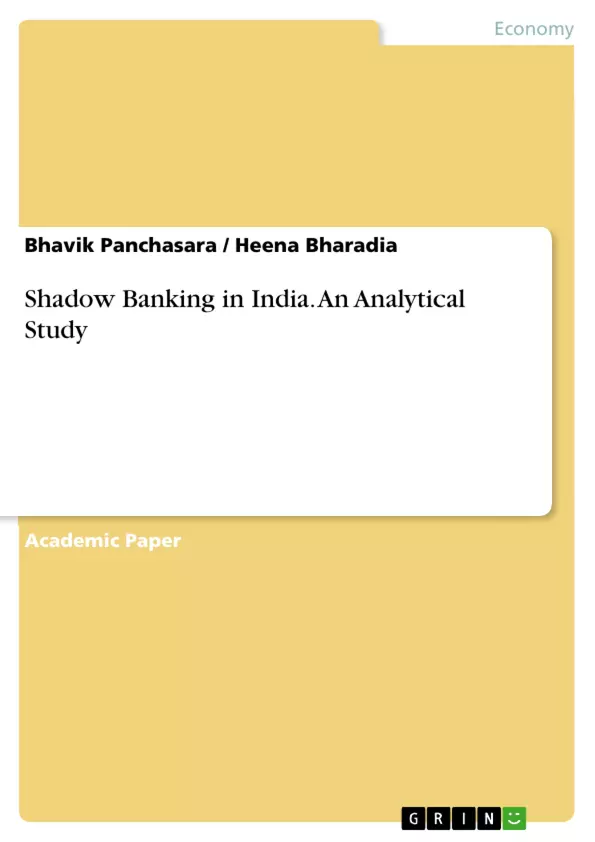After the horrible experience of the great financial crisis of 2008, the world has now become more anxious and serious about the existence, contribution, magnitude, significance and risks of the non-banking financial sector (NBFS). The sector was neglected from the beginning either by default or by deliberate choice but now the sector has enhanced attention, monitoring and regulation as a post-crisis lesson. In this context, the raising of boundaries of non-banking financial companies (NBFCs) came up with the risk of evolution of shadow banking. However, the concept of ‘shadow banking’ came into existence in 2007; when Paul McCulley coined the term ‘shadow bank’. Shadow banking includes credit intermediation involving entities (NBFCs) and activities (fully or partially) outside the regulated banking system of any country.
In the developing economies like India, shadow banking plays a gainful role in credit delivery and financial inclusion. They play substitute as well as a complementary role for commercial banks as they able to fulfill the needs of borrowers outside the preview of the regulated banking system. However, shadow banking becomes very risky because it operates outside the regulated banking system and financial intermediation activities are undertaken with less transparency and regulation than the conventional banking. Up to certain level, it helps the financial system to grow; but beyond it, may prove dangerous. This paper focuses on the concept of shadow banking and its prevailing structure and effects in India.
Table of Contents
- Abstract
- Introduction
- The Concept of Shadow Banking
- Global Perspective
- Shadow Banking in India
- Growth of NBFC Sector in India
- Threats and Regulatory Challenges for Indian Economy
- Financial Stability and Systemic Risk Threats
- Regulatory Arbitrage Spread Globally
- Affects the Monetary Policy
- Pro-cyclicity and amplification of business cycles
- Regulations by RBI
- Conclusion
- References
Objectives and Key Themes
This paper examines the concept of shadow banking and its structure and effects in India. It aims to provide a comprehensive analysis of this phenomenon, which has gained significant attention in the wake of the 2008 financial crisis. The paper explores the role of shadow banking in credit delivery and financial inclusion in developing economies, as well as the associated risks and regulatory challenges.
- The definition and evolution of shadow banking
- The role of non-banking financial companies (NBFCs) in shadow banking
- The potential threats posed by shadow banking to financial stability and systemic risk
- Regulatory measures implemented by the Reserve Bank of India (RBI) to manage shadow banking risks
- The impact of shadow banking on the Indian economy
Chapter Summaries
- Introduction: This chapter introduces the concept of shadow banking and its significance in the context of the 2008 financial crisis. It highlights the increasing attention given to the non-banking financial sector (NBFS) and the role of NBFCs in the evolution of shadow banking.
- The Concept of Shadow Banking: This chapter defines shadow banking and discusses its various interpretations. It explores the activities and entities involved in the shadow banking system, including credit intermediation, maturity transformation, and securitization.
- Global Perspective: This chapter provides an overview of the global landscape of shadow banking, examining its presence and implications in different countries.
- Shadow Banking in India: This chapter focuses on the specific context of shadow banking in India, analyzing its role in credit delivery, financial inclusion, and economic growth.
- Growth of NBFC Sector in India: This chapter examines the growth and evolution of the NBFC sector in India, highlighting its importance in the Indian financial system.
- Threats and Regulatory Challenges for Indian Economy: This chapter explores the risks associated with shadow banking in India, including financial stability concerns, regulatory arbitrage, and the impact on monetary policy.
- Regulations by RBI: This chapter discusses the regulatory measures implemented by the RBI to manage shadow banking risks in India.
Keywords
This paper focuses on the key concepts of shadow banking, non-banking financial companies (NBFCs), non-banking financial sector (NBFS), financial system, financial inclusion, credit delivery, regulatory challenges, and systemic risk. The paper examines the interplay between these concepts in the context of the Indian economy.
- Quote paper
- Bhavik Panchasara (Author), Heena Bharadia (Author), 2018, Shadow Banking in India. An Analytical Study, Munich, GRIN Verlag, https://www.grin.com/document/425631



